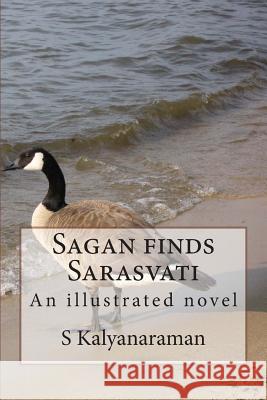Sagan Finds Sarasvati: An Illustrated Novel » książka
Sagan Finds Sarasvati: An Illustrated Novel
ISBN-13: 9780982897171 / Angielski / Miękka / 2013 / 172 str.
Sagan owns an ancestral brass foundry in Jagadhri, India, where copper and zinc are alloyed to create trade mark Jagadhri brass vessels. The author born in Kidarankondan Tamil-speaking province and educated in Telugu in Penukonda meets Sagan after returning from Manila, Philippines. Together they travel around the globe and visit Louvre and other museums in search of Sarasvati, the Himalayan river and attempt to read the message of Shu-ilishu cylinder seal in cuneiform writing. The novel reports that Sagan has found Sarasvati and her divine message, using ancient links between Ancient Near East and South-Southeast Asia. Sagan Munda and Karmi Hatu, manage the brass foundry close to the place where Sarasvati surfaces into the plains, flowing from Manasarovar glacier. They are like a pair of monogamous extraordinary Anser Indicus, hamsa birds, which can fly at heights above 24000 feet during their annual migrations with their goslings, and across the Himalayan ranges from Europe into India. The couple are caught up in a court-room drama contending with academics from an Ivy League University. Sagan acts like a detective in his search for Sarasvati River which is venerated in ancient songs and dances of India. Father Brown is the role model for Sagan as a detective. Sagan was charged with the crime of forgery of an Indus seal image from Daimabad, the proceedings in the court recollect a Harvard Donkey case to provide a spirited summing up to prove Sagan's innocence and literacy of his ancestors. Defense proved allegedly forged image to be that of a rim of a narrow-necked jar. The narrative moves beyond the evidence phase, browsing across Indus script corpora and Karmi Hatu presents in an ABC News interview the true story and functions served by the Indus script inscriptions. The defense convinces the Jury with evidence drawn from expansive civilization areas of not only seals, tablets, cultural-religious traditions, religious, visionary and metaphysical insights from South-Southeast Asia but also Code of Hammurabi, cylinder seals, ritual basin, Sit-Shamshi bronze sculpture excavated at Susa in Sumer, Ancient Near East. Method used to writing in Egyptian hieroglyphs is demonstrated for the famous Narmer Palette by a combination of catfish (n-r) and chisel (m-r) which together read rebus to denote the name of Emperor Narmer of the 31st century BCE while the earliest evidence of writing on Sarasvati River basin is archaeologically dated to 33rd century BCE. The narrative spans over 7 millennia of civilization history and cites the examples of glyphs and metaphors of a dancing-girl shown, respectively, on a potsherd from Bhirrana and on a bronze statue, from Mohenjodaro both excavated from the banks of the same Sarasvati channel which continued into Sindh province, Clinching evidence comes from an unsuspected source which Father Brown had declared was due to the failure to notice the postmen who carry large-sized bags which could also be used to carry corpses after committing a murder. It is from a paper presented in a World Sanskrit Conference by a linguist who finds two concordant words, one from the Vedic language and the other from Tocharian, spoken in the foothills of Muztagh Ata. This clinching evidence resolves the mystery of Soma yajna performed for millennia on the banks of River Sarasvati. The narrative covers geological domains of plate tectonics to explain the Himalayan range which extends from Teheran in the west to Hanoi in the East and river migrations resulting in celebration of Kumbh mela at Prayag every 12 years to worship the confluence of Rivers Sarasvati, Yamuna and Ganga. The monogamous pair of Anser Indicus birds are the witnesses, in time and space, across the vast geographic domain of civilization contact areas. Reflectence Imaging Technology, and lexicon of 25 languages of Indian sprachbund are used to prove Sagan's innocence and that Bos Indicus was a smelter-furnace of a Guild of metalsmiths.











